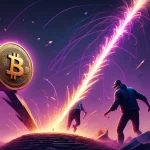XRP Surges to $3, Outpacing Bitcoin and Ethereum: Can the Rally Hold?

XRP Price Surges to $3, Outpacing Bitcoin and Ethereum: Is This Rally Built to Last?
XRP has stormed past the $3 mark in a blistering rally, clocking a staggering $11.8 billion in trading volume that leaves Bitcoin (BTC) and Ethereum (ETH) trailing in its wake. Fueled by retail investor frenzy, particularly from South Korea, this altcoin is stealing the spotlight—but is this surge a genuine breakout or just another crypto mirage?
- Price Explosion: XRP hits $3 with $11.8B in volume, boasting a 25% weekly gain against BTC’s 10.5% and ETH’s 19%.
- Retail Dominance: South Korea’s Upbit exchange drives over 70% of the buying, with 45 million XRP pushing prices from $2.60 to $3.00.
- Key Catalysts: U.S. crypto legislation, a nearing SEC lawsuit resolution, and spot ETF hopes could shape XRP’s trajectory—for better or worse.
South Korean Retail Frenzy: The Engine Behind XRP’s Rise
The numbers don’t lie—XRP’s ascent to $3 is nothing short of spectacular. With a trading volume of $11.8 billion in a single day, it has outshone both Bitcoin and Ethereum, not just in volume but in returns, posting a 25% weekly gain compared to BTC’s 10.5% and ETH’s 19%. The driving force? Retail investors, with South Korea’s Upbit exchange leading the charge. Over 70% of the buying pressure—equivalent to 45 million XRP—came from Upbit, propelling the price from $2.60 to $3.00 in mere hours. The exchange alone recorded nearly $500 million in 24-hour volume for XRP, surpassing the combined volume of BTC and ETH on its platform, as highlighted in recent trading volume analysis from South Korea. Other exchanges like Coinbase (11%), Kraken (9%), and Bitstamp (6%) contributed modestly, while Binance saw negative flows, revealing a stark regional disparity in market enthusiasm.
Why South Korea? With over 7 million locals—about 15% of the population—registered on crypto exchanges, the country has earned its reputation as a crypto trading hotbed. Many South Koreans, having missed Bitcoin’s early meteoric rise, are now hunting for the next big thing, and XRP, with its promise of fast, cheap cross-border payments, fits the bill. This cultural obsession with digital assets, paired with an export-driven economy reliant on efficient transactions, makes XRP particularly appealing. But let’s not kid ourselves—retail-driven pumps, while dazzling, often lack the legs for a marathon. As analyst Dom noted, South Korea’s influence on XRP is massive but neutral; it’s just one market with outsized interest at this moment, a sentiment echoed in analysis of South Korean retail investor trends. If the hype fades or profit-taking kicks in, this rally could unravel faster than a cheap sweater.
Technical Outlook: Can XRP Keep Climbing?
For the chart-watchers among us, XRP’s price action is painting a bullish picture—at least on the surface. The token has broken out of a falling wedge pattern, a technical formation often signaling a reversal from a downtrend to bullish momentum. Analysts are eyeing a potential target of $4.365, a 46% upside from $3, based on the 2.618 Fibonacci extension—a mathematical level traders use to predict price targets based on historical swings. Momentum indicators add to the optimism: the weekly Relative Strength Index (RSI) sits at 65, well below the overbought threshold of 70, suggesting there’s room to run. A MACD golden cross, where two key trend lines intersect to indicate bullish momentum, further hints at a possible long-term uptrend, as discussed in broader XRP price prediction analyses.
But hold the victory lap. If XRP fails to hold the psychological $3 barrier, a correction could drag it back to $2.66, aligning with the 1 Fibonacci retracement level—a common support zone during pullbacks. For those new to this, Fibonacci levels are derived from a mathematical sequence and are widely used in trading to identify potential reversal points. Simply put, XRP’s next move hinges on whether it can cement this breakout or get slapped down by market resistance. Retail euphoria is one thing; sustaining momentum against profit-takers and bearish sentiment is another beast entirely.
Regulatory Catalysts: A Double-Edged Sword for XRP
Beyond the charts, XRP’s future may well be shaped by events unfolding in Washington, D.C. The U.S. House is gearing up for what’s been dubbed “Crypto Week,” with votes on key legislation that could redefine the digital asset landscape. The GENIUS Act, already passed by the Senate with bipartisan support, targets the $238 billion stablecoin market, aiming to regulate tokens pegged to fiat like the USD. While not directly tied to XRP, it could set a precedent for broader crypto clarity. The CLARITY Act seeks to define which digital assets fall under securities laws—a direct relevance to XRP’s ongoing battles—and the Anti-CBDC Surveillance State Act pushes back against centralized digital currencies, aligning with crypto’s decentralized ethos, as detailed in coverage of U.S. crypto legislation for 2025.
As crypto analyst Nic Puckrin points out, stablecoin regulation could reinforce U.S. economic dominance since 99% of these tokens are USD-pegged, potentially creating a ripple effect of legitimacy for assets like XRP. Senator Bill Hagerty warns that without a framework, “stablecoin innovation will proliferate overseas—not in America,” framing this as a competitiveness issue. Yet, critics like Senator Jeff Merkley caution that these bills lack guardrails against corruption, questioning whether officials could profit from specific tokens. For decentralization purists like myself, this hits hard—regulation might stabilize markets, but at the risk of backdoor centralization or surveillance that betrays crypto’s core promise of freedom.
Closer to XRP’s heart, the long-standing SEC lawsuit against Ripple, its parent company, is nearing a resolution. Since December 2020, this legal saga has debated whether XRP qualifies as a security, casting a shadow over its market perception. Ripple CEO Brad Garlinghouse recently dropped a cross-appeal, signaling an endgame that could lift this regulatory albatross. Add to that the buzz around a spot ETF for XRP, currently under SEC review with a 95% approval likelihood by 2025 per AInvest analysts, as explored in updates on the SEC lawsuit and ETF potential. If greenlit, projections suggest up to $8 billion in inflows, akin to the institutional flood seen with Bitcoin and Ethereum ETFs. For the uninitiated, a spot ETF lets investors track XRP’s price without holding the asset directly, often drawing in Wall Street players wary of unregulated markets. But beware—ETFs can also invite volatility from speculative institutional bets, and regulatory “clarity” might come with strings that choke innovation. It’s a tightrope walk.
XRP’s Ecosystem: Utility Beyond the Hype
While the price surge grabs headlines, XRP’s underlying ecosystem is quietly building muscle. The XRP Ledger continues to evolve with updates enhancing scalability and interoperability. Integrations like USDC stablecoins on the ledger bolster its use case for cross-border payments, and the anticipated 2025 launch of an EVM (Ethereum Virtual Machine) mainnet could open doors to decentralized finance (DeFi) applications, potentially rivaling Ethereum’s dominance in that space. For context, EVM compatibility means developers can build smart contracts on XRP’s network, much like they do on Ethereum, expanding its utility beyond simple transactions, as explained in detailed information about the XRP Ledger.
Let’s talk raw numbers to highlight XRP’s niche. Transactions on the XRP Ledger settle in 3-5 seconds at a cost of fractions of a cent, compared to Bitcoin’s 10-minute average and fees that can spike to $50 during congestion, or Ethereum’s gas fees that often hover in the double digits. This speed and cost-efficiency make XRP a go-to for financial institutions tackling cross-border remittances—a $781 billion market in 2022 alone. Ripple’s partnerships with banks and payment providers underscore this practical edge, even if it earns sneers from Bitcoin maximalists who see XRP as a “banker’s coin” too cozy with traditional finance. I’m a BTC diehard at heart, but credit where it’s due: XRP fills a gap Bitcoin isn’t designed to address, proving that diverse use cases strengthen the broader crypto revolution.
XRP vs. Bitcoin: Niche Player or True Contender?
So, can XRP overtake Bitcoin? Let’s cut through the noise: not likely in the foreseeable future. Bitcoin reigns as the unchallenged king of crypto, a store of value and symbol of decentralized rebellion against fiat systems. Its cultural and ideological weight—rooted in censorship-resistant money—dwarfs XRP’s more utilitarian focus on payments. XRP’s market cap, even at this peak, is a fraction of Bitcoin’s, and overtaking it isn’t just about numbers; it’s about shifting a deeply entrenched narrative. Bitcoin maximalists might argue XRP’s ties to Ripple, which controls a hefty chunk of the token supply, undermine the decentralized ethos BTC embodies. It’s a fair jab—Ripple’s influence raises eyebrows among those of us who see pure decentralization as non-negotiable, a comparison further explored in market performance insights on XRP versus Bitcoin and Ethereum.
Yet, there’s a flip side. XRP’s efficiency in transactions serves a real-world need Bitcoin doesn’t prioritize, and that’s okay. Not every blockchain has to be a carbon copy of BTC to have value. As someone who cheers for effective accelerationism, I see XRP’s disruption of clunky financial systems as a win, even if it’s not the ideological north star Bitcoin represents. The real question isn’t whether XRP can dethrone BTC, but whether it can carve out a lasting niche as regulatory and institutional tailwinds align. If it does, it’s a testament to the power of specialized roles in this financial uprising.
Risks and Hype Traps: Don’t Get Blinded by the Shine
Amid the excitement, let’s not ignore the red flags. Retail-driven rallies, especially ones so concentrated in a single region like South Korea, can collapse as quickly as they ignite. Without broader adoption or institutional backing, XRP risks a sharp pullback if Upbit traders cash out en masse. A rejection at $3 could trigger that dreaded correction to $2.66, and history shows XRP has danced near these heights before—hitting $3.40 in the 2017-18 bull run—only to crash spectacularly. Lessons from the past remind us that fundamentals, not just hype, must hold the line, a concern also raised in community discussions on XRP’s surge in South Korea.
Then there’s the distraction of speculative noise. While XRP grinds on utility, flashier narratives—think meme coins promising absurd returns—steal retail attention. These shiny objects often end in rug pulls or scams, and speaking of which, beware the opportunists riding XRP’s wave. Social media is already buzzing with fake giveaways and phishing schemes promising “free XRP.” If it sounds too good to be true, it’s probably a trap—protect your wallet. And on the regulatory front, even “positive” developments like an ETF could usher in volatility from institutional speculation, while overzealous laws might erode the privacy and freedom crypto stands for, a topic debated in forums like discussions on the SEC lawsuit’s impact on XRP’s price. XRP’s rally is a middle finger to traditional finance, but the road ahead is littered with potholes.
Key Takeaways: Unpacking XRP’s Moment
- What’s powering XRP’s surge to $3?
Retail investors, led by South Korea’s Upbit exchange with over 70% of the buying volume (45 million XRP), are the main drivers behind this rapid price jump from $2.60 to $3.00. - Is XRP’s lead over Bitcoin and Ethereum sustainable?
Outperforming BTC (10.5% weekly gain) and ETH (19%) with a 25% gain is impressive, but retail-driven surges often fizzle without institutional or fundamental support to anchor them. - Could regulatory shifts be XRP’s turning point?
Yes—U.S. bills like the GENIUS and CLARITY Acts, a nearing SEC lawsuit resolution, and a potential spot ETF with $8 billion in projected inflows could legitimize and boost XRP. - Will XRP ever rival Bitcoin’s dominance?
Highly unlikely soon; Bitcoin’s cultural and market stronghold overshadows XRP, though its payment-focused utility secures a valuable niche in the crypto ecosystem. - What risks loom over XRP’s current momentum?
A price rejection at $3 could drop it to $2.66, regional retail hype risks sharp pullbacks, and scams exploiting the rally pose threats to unsuspecting investors. - Does regulation endanger crypto’s decentralized roots?
It’s a mixed bag; while clarity could stabilize markets like XRP’s, overreach threatens centralization, clashing with the privacy and freedom blockchain champions.
XRP’s climb to $3 is a bold statement in a market often dominated by Bitcoin’s shadow, a reminder that altcoins can disrupt and dazzle when the stars align. As a champion of decentralization and effective accelerationism, I’m thrilled to see XRP challenge the status quo, proving that blockchain can dismantle outdated financial systems one transaction at a time. But let’s keep our eyes wide open—South Korean retail pumps are fragile, regulatory “wins” might bind us in new chains, and speculative distractions lurk around every corner. XRP’s milestone is a battle cry for innovation, but whether it echoes into a lasting revolution or fades as a fleeting roar depends on grit, not just glamour. Keep your skepticism sharp and your curiosity sharper; the crypto game is far from over.



